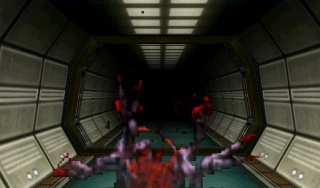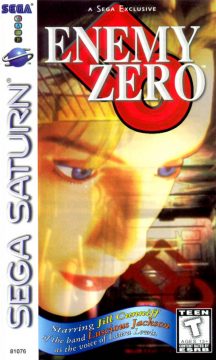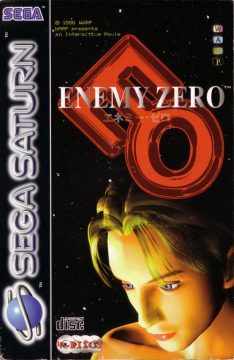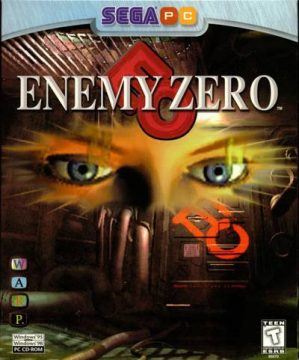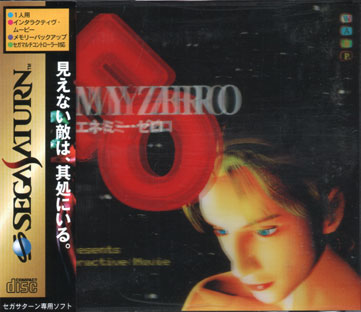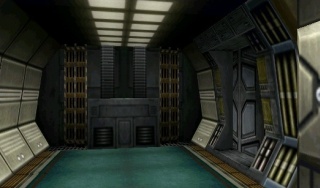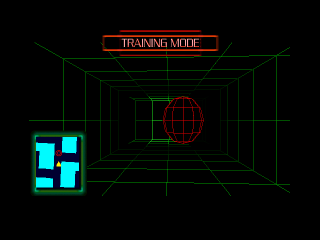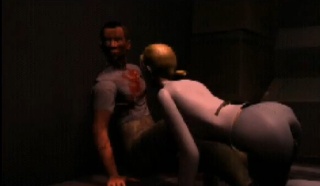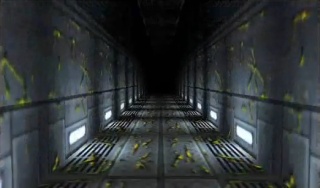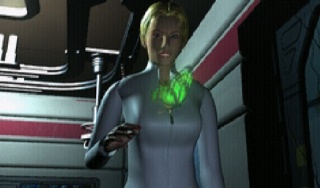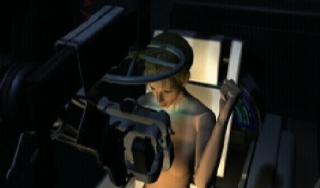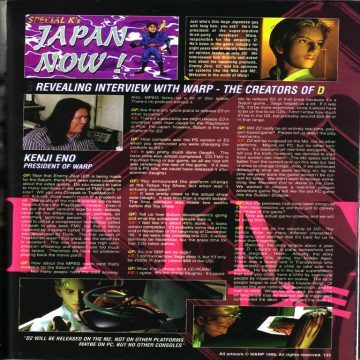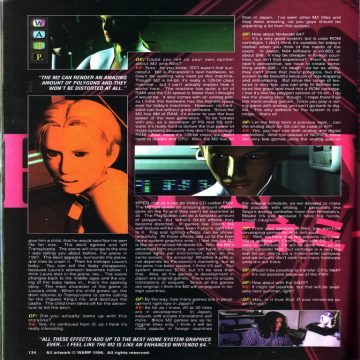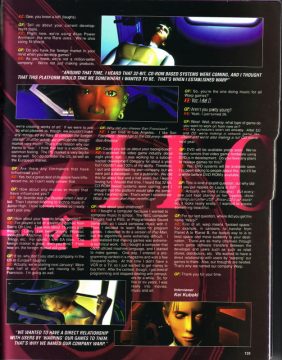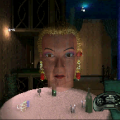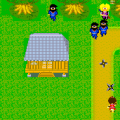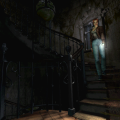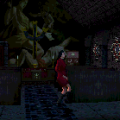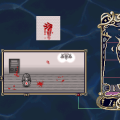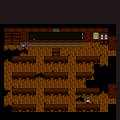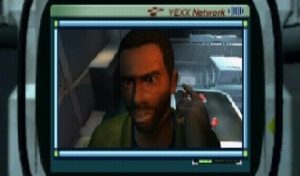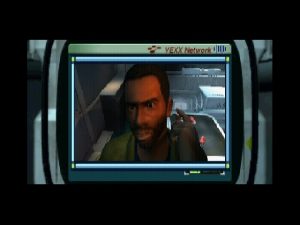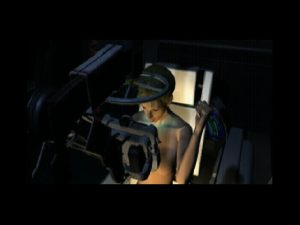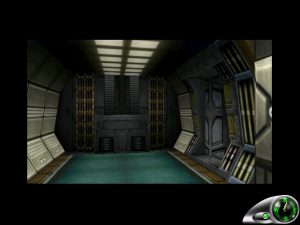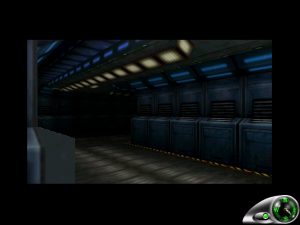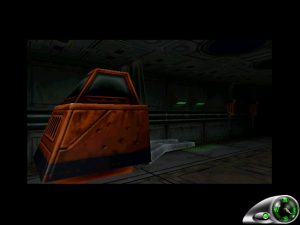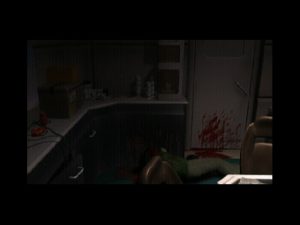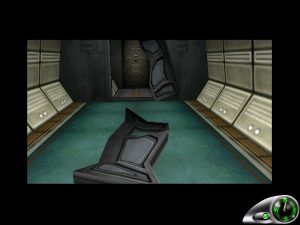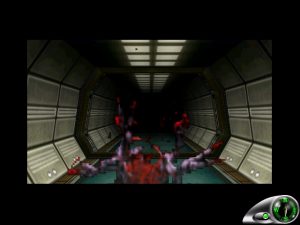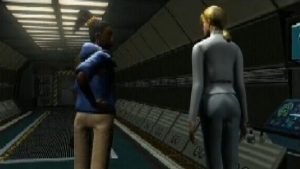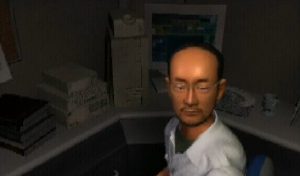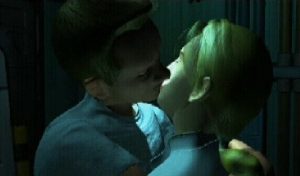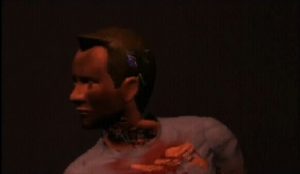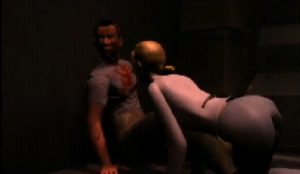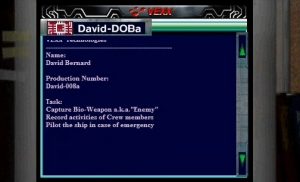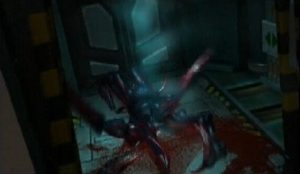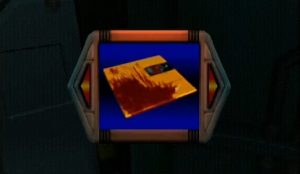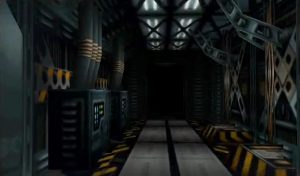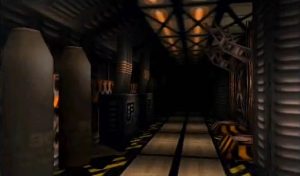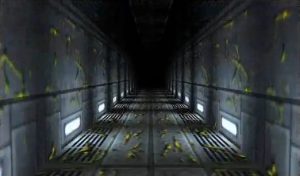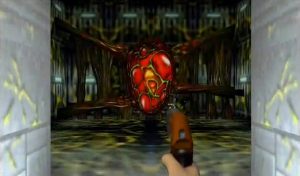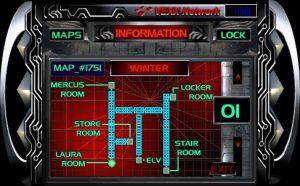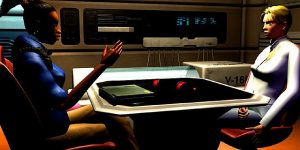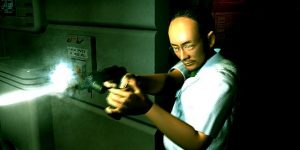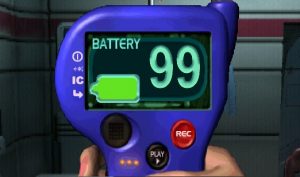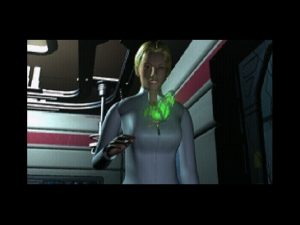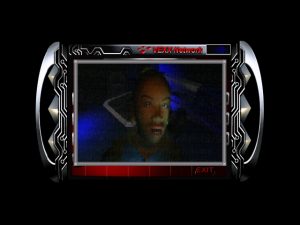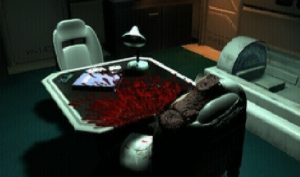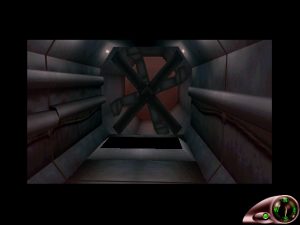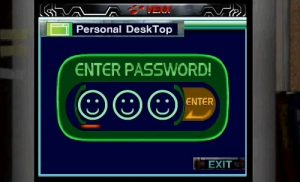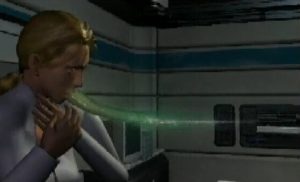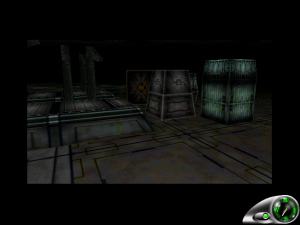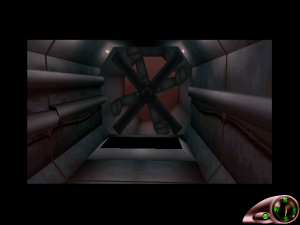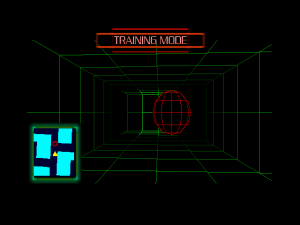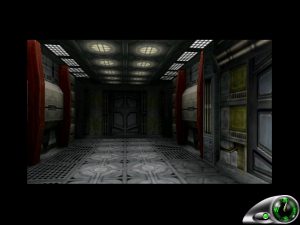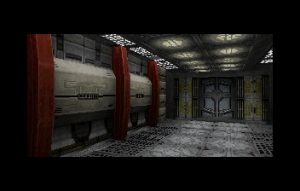Of all of Warp’s games, Enemy Zero is probably the most conceptually interesting in terms of mechanics, even if it’s the most difficult and bordering on unplayable. Actually difficult is the wrong word, and it’s important to emphasize that criticism for it isn’t simply because of the difficulty, rather the way reloading and movement have been made intentionally slow, which makes the game’s learning process frustrating.
The basic premise is ripped straight out of Ridley Scott’s Alien, with blonde protagonist Laura waking from cryosleep on the spaceship Aki (which resembles a human heart) on its return voyage to Earth, and all hell breaking loose due to alien nasties on board. Rather than a single xenomorph there are several, and the catch is they’re entirely invisible to human eyes. Laura is suffering from amnesia but manages to arm herself and dispatch a few aliens, while attempting to re-unite with the crew, who are being picked off one by one.
E0 follows the original D, containing adventure sections based around static CG locations, where Laura can interact with and pick up items. These are generally slow and poorly rendered, but are the only place where you can save, meet characters or recharge guns. You also have semi-regular access to the ship’s computers to make video phonecalls, disengage various locks, and look up background information.
A big departure from D are the free-roaming polygonal environments you can explore, which is also where combat takes place. Since enemies can’t be seen, Laura has a radar device in her ear, which makes a variable noise depending on the direction of an enemy and its proximity. If an enemy is in front of the player the noise is high pitched, while at the sides and behind it is lower, with the frequency of beeps increasing as you get closer. There’s a tutorial explaining how it works, though using only audio to gauge an enemy’s position isn’t as cleverly implemented as it could have been. When you think an enemy is directly in front of you, and within range of your gun, you need to hold down the fire button to charge it and then release. Enemies die in a single shot, but it’s extremely easy to miss by a small margin, or overcharge the gun in which case it resets to zero. In both cases you’re likely to die since the alien will be right in front of you.
These areas have slick controls and resemble your typical FPS, though any excitement regarding this is short lived since the sections are rather bland. There’s no interactivity apart from fighting the invisible enemies, and besides a couple of wide open cargo spaces they consist solely of identical (and I mean absolutely identical) corridors and air ducts.
The game’s general flow is exploration of the static CG scenes for items such as key cards, followed by a tough slog through a confusing maze of corridors to reach the next CG section before an enemy finds you. Weapons are available but on several occasions are lost, and furthermore can only hold a couple of charges before needing replenishing at a utility room. Miss an enemy too many times and you’ll be scrambling back in retreat. Saving is done via a voice recorder with limited battery power. On easy it has a charge of 99, and on normal 64. Using it to save depletes it by 3 units, allowing a maximum of 33 saves on easy and 21 on normal.
Characters
Laura
Technically a different Laura to the one in D, she’s a kind of digital actress created by WARP. Waking up with amnesia she soon comes to remember her love for crewmember David when they share an embrace, and is later deeply affected by his death. After being infected by one of the aliens, Laura discovers that she’s in fact a robot, placed on the ship to monitor the crew and oversee acquisition of the alien species. Ultimately she is the only survivor. Voiced by Jill Cunniff, of the real-life band Luscious Jackson.
Parker
An African-American who is the ship’s engine pilot and husband to Kimberly. He is most likely modeled on the Parker character from the film Alien. As one of the first crewmembers to die you don’t interact with Parker beyond seeing him on videophone. You’re able to read his computer diary entries, and later it’s revealed that he was secretly working for a military company which intended to buy the alien creatures. Enjoys ornithology.
Kimberly
Wife to Parker, she too secretly works for the military company which intends to buy the aliens. Kimberly later comments that Laura was present at her and Parker’s wedding, oblivious to being a robot, and was extremely happy for them. After Parker’s death Kimberly confronts the aliens and goes missing, re-appearing later to cut out the infection in Laura’s neck. At the end of the game she chooses to commit suicide beside her beloved Parker.
David
Drinks vodka, has a bad temper, and hates to see it rain. He is Laura’s lover, and is also a robot placed on the ship to monitor the crew and oversee capture of the alien. After sharing a passionate embrace with Laura he goes off to do his own thing and is later found severely damaged. Laura extracts the memory chip from his damaged body. At the game’s end when her listening device for detecting the aliens breaks, David’s uploaded conscience guides her from the ships’ central computer via the intercom system.
George
Japanese computer engineer. He knows more than he lets on and later confesses to the company’s desire to sell the biological weapon. Is disappointed at how things turned out, since it means he won’t get his promotion. Also explains to Laura how it was he who implanted her fake memories of life on Earth (things go a bit Bladerunner at this point). Before getting killed he tries to persuade Laura to let him fix her damaged memory so she can live like a real human. How sincere he was is debatable.
Mercus
Ship’s doctor from Germany. He doesn’t play much of a role besides being found as a headless corpse. Laura has to pick up the bloodied remains of his fingers to open a DNA-encrypted lock which yields her first gun.
The story follows a fairly predictable course. First ship’s driver Parker is killed over videophone, and then Laura discovers the ship’s doctor Mercus is dead. Laura then joins up with Kimberly before an event that apparently leaves Kimberly also dead. Laura then meets George who is programming a special key card, and then David. Soon after David is found half-dead and it’s discovered he’s an android – profoundly affecting Laura. The two share a moment where David confesses his eternal love for her. She hacks into George’s computer to discover the truth behind the ship’s mission, after which she’s infected with an alien parasite during a rather disturbing tentacle fellatio scene (which would re-appear in the Japanese D2 on DC). When she visits the medical room to scan herself, Laura makes the shocking discovery that she too is an android.
It turns out the ship was ordered to capture the aliens, referred to as ‘the enemy’, in order to sell as biological weapons – just like in the film Alien. Computer engineer George is implicated in the cover up and not long after is killed by an alien. Laura carries on, determined to escape, and re-unites with Kimberly who it turns out didn’t die. After cutting Laura’s neck with a knife to remove the parasite (which resembles some kind of perverse glow-in-the-dark bratwurst), Kimberly returns to Parker’s room to commit suicide alongside her husband. With the ship’s emergency self-destruct activated, Laura heads for the escape shuttle guided over the intercom by the voice of David, who has been uploaded into the ship’s computer.
With the story not quite as disgusting as the original D‘s, and nowhere near as sexually disturbing or plain weird as the subsequent D2, E0‘s allure lies in its unusual mechanics. Namely the combat with invisible enemies, and the limited save functionality.
Games which tackle the philosophical design riddle of save implementation in unusual ways usually prove interesting: Resident Evil‘s limited save ribbons, Steal Battalion‘s save file deletion and Demon’s Souls instant saving are all fantastic ways of keeping players on their toes. Likewise with E0, the concept of starting with a non-replenishable amount of saves is an excellent way to generate terror, force resource management, and generally lend proceedings an atmosphere of guerrilla warfare. Games today spoil players with not only an infinite amount of saves, but in many cases the ability to save anywhere plus regular checkpoints, thereby castrating any semblance of challenge, tension, or even basic design. In practice in E0 you actually have more save chances (21) than you need, since the game can be completed in about 3 hours. If you can survive for eight minutes at a time, you’ll do fine.
Equally if not more impressive, at least from a conceptual point of view, is E0‘s continuous attempt to do interesting things with sound, such as when fighting or being guided by surviving crew members. Unfortunately the poor implementation during combat renders it almost unplayable.
For a start there is no stereo sound for the radar, and instead of hearing it in a single ear the pitch of the beeping changes depending on the direction of a creature. Which makes sense in the context of the game, where Laura has a single earpiece in one ear – but in practice it makes things more difficult than they need to be. Additionally, if there’s more than one enemy nearby it becomes impossible to disentangle the sounds. Though the beeping becomes faster the closer you get, it’s extremely difficult to judge when to fire, further complicated by the long charge times needed for guns and their limited ammo. Success requires absolutely perfect timing, which many will likely find impossible today.
The continuous string of Game Overs wouldn’t be so problematic if restarting was quick and painless, but it forces you to return to the title screen, go through the arduous task of watching the LOAD FMV clip, and then you’re forced to listen to an audio track where Laura explains the story, again. In fact, absolutely no FMV can ever be skipped, which is infuriating especially given how slowly they play out. Three deaths in a row and you could waste 20 minutes trying to progress through a relatively short section of game.
This ultimately kills any tension. The first time you have to run from the telltale beeping of an invisible enemy it’ll probably be one of the most terrifying experiences in survival horror gaming, up there with the best that System Shock and Dead Space can offer. After the second, third and twelfth time redoing that same section, the effect kind of wears off.
Even if the combat doesn’t prematurely cull your playing, the levels themselves aren’t much to look at and getting lost is guaranteed. We’ve not used many screens of the polygonal sections, since any given spot in a particular area looks much the same as the next, with variety only occurring between areas. For those Eno-loving masochists who must complete E0, here is a series of maps and a guide taken from Dextremes, which prove handy.
Eno was actually questioned on the high difficulty of E0 by 1UP, and his response likened it to a curry fan enjoying some spice:
It’s a difficult game, but that’s the good part of Enemy Zero. You know, when you eat curry, it’s spicy. That’s why it’s curry. That’s why it’s good. So it’s the same with Enemy Zero. The whole experience that you gain from playing a difficult game is valuable. If I had a chance to make it all over again, I would probably make it the same way, because that’s the feeling I wanted to deliver. I have no regrets about Enemy Zero, and the difficulty is what Enemy Zero is. That’s the important part of the game.
As it stands, Enemy Zero is a charming relic from an experimental era; bordering on unplayable by today’s standards, but fascinating to ponder. As games continue to implement save-anywhere mechanics, infinite ammunition (such as in the recent remake of AvP with the default pistol), and recharging health, it’s doubtful we’ll ever see anything quite like Enemy Zero again. Which is tragic, because you could create something truly astounding with the concepts here.
The game was originally developed first for the Sega Saturn and released internationally. It was later ported by Sega to Windows PCs. The PC version should be regarded as definitive as it runs in a higher resolution and has improved textures – there’s also supposed to be a greater variety of enemies. There’s no mouse support, but it does recognise USB controllers such as the Sega Saturn USB pad.
An interesting bit of trivia is that Fumito Ueda of Team Ico is credited on E0. As explained by Eno:
At the very beginning, he didn’t pass the application process at WARP. But I still remember the work that he submitted; it was about a dog running in the rain. His technology as an animator, as a CG artist, wasn’t that great, but his ideas and his concepts really struck me, so even though he originally wasn’t on the hiring list, I handpicked him because I saw his potential. People ask me a lot about Ueda, but he didn’t stay at Warp for long. It’s not like I groomed him or anything.
Around the time of Enemy Zero‘s release there was a detailed interview in GameFAN magazine, which contains some fascinating insight into the game, the unreleased D2 on M2, Kenji Eno’s history, and WARP itself. It also answers the question of why Laura doesn’t have any nipples in the E0 CG scenes.
The soundtrack was composed by British musician Michael Nyman, who did the soundtrack for films such as The Piano. As Kenji Eno explained to 1UP:
I like Michael Nyman a lot, and I like his soundtracks, so I was thinking that it would be awesome if I could get him to do the music. I think the juxtaposition of the game’s aesthetic and his music makes it a perfect match. I wanted to get him really bad. And then, there was a big earthquake in Kobe, Japan in 1995, and Michael Nyman was donating pianos to schools in the city. When this earthquake happened, he said that he wanted to check out how the pianos that he donated were doing, so he came to Japan. When I found out that he was in Japan, I invited him back to my hotel room and tried to convince him, for six hours, to come work with me. So, at the end, Michael was like, ‘OK, I’ll do it, I’ll do it. Just let me go back to my room.’ We didn’t work out terms or conditions; he just said that he would do it. And that’s the way I convinced him.
The OST disc contains 14 tracks from the game.
